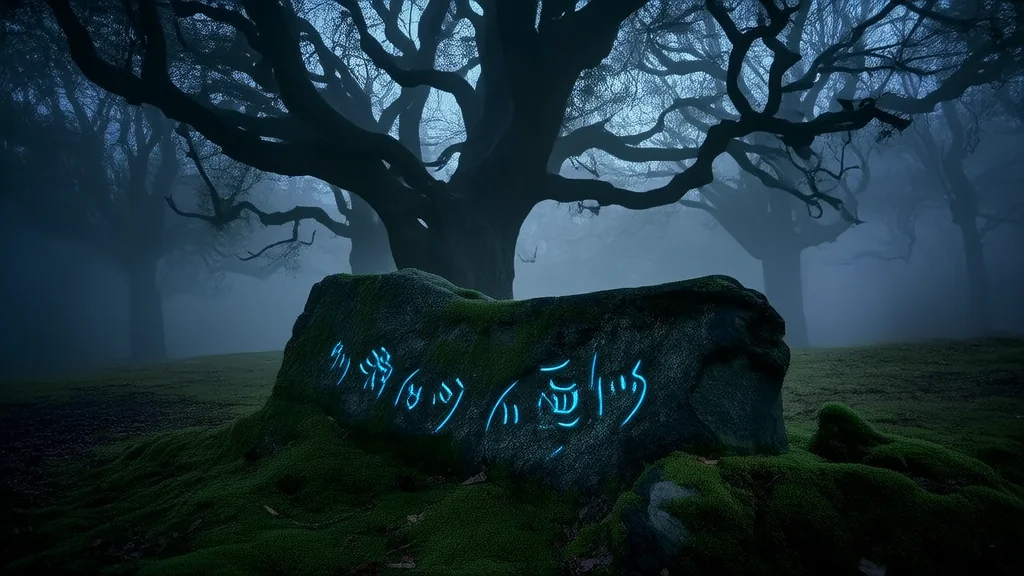🔮 Weird Tales & Urban Legends
The Curse of the Hollow Stone: Secrets Beneath the Ancient Oak in Elmhollow's Whispering Forest

The village of Elmhollow was nestled deep in the forest, where the trees grew so tall they seemed to touch the sky. Few ever visited, and those who did often left with a strange feeling, as if something had been watching them from the shadows. The locals spoke of an old legend, one that only the elders remembered: the curse of the Hollow Stone.
It was said that centuries ago, a group of travelers stumbled upon a strange monolith hidden beneath the roots of an ancient oak. The stone was carved with symbols no one could decipher, and when they touched it, they vanished without a trace. Over time, the villagers built their homes around the tree, but never dared to go near it. A hush fell over the area whenever someone mentioned the stone, as if even speaking its name might awaken something long forgotten.
One summer evening, a young woman named Lila arrived in Elmhollow. She was an archaeologist, drawn by rumors of the cursed stone. She had read about it in old journals and believed it to be a mere myth. But as she walked through the quiet streets, she felt an undeniable pull toward the forest.
She found the tree easily, its bark gnarled and twisted, as though it had seen too much. Beneath it, the ground was uneven, and at its base lay the monolith. It was taller than she expected, its surface etched with spirals and symbols that seemed to shift when she looked away. She knelt beside it, brushing away the moss, and felt a chill run down her spine.
As she traced the carvings with her fingers, the air around her grew still. The wind died, and the usual sounds of the forest—birds, insects, rustling leaves—faded into silence. Then, a whisper, barely audible, echoed in her ears. It was not a voice, but a sensation, like a memory trying to surface.
Lila stood up, heart pounding. She had heard stories of people going mad after touching the stone, but she told herself it was just superstition. Still, she couldn’t shake the feeling that she was being watched. She took a step back, and the tree’s branches creaked as if in warning.
Over the next few days, Lila stayed in the village, researching the legend. She spoke to the elders, who spoke in hushed tones, offering little more than vague warnings. One old man, his eyes clouded with age, told her, “The stone doesn’t take lives. It takes memories. It shows you what you’ve forgotten, and sometimes, what you wish you had.”
That night, Lila dreamed of a place she had never seen. She stood in a vast hall filled with mirrors, each reflecting a different version of herself. Some were happy, some sorrowful, others empty-eyed and hollow. In the center of the room was the monolith, pulsing with a faint glow. When she reached out, the mirrors shattered, and she woke up drenched in sweat.
The following morning, Lila returned to the tree. This time, the symbols on the stone glowed faintly, as if responding to her presence. She pressed her palm against it, and the world around her shifted. The forest melted away, replaced by a vision of a long-lost village, its people gathered around the same stone. They were chanting, their faces lined with fear and reverence. Then, the scene changed—she saw them vanish, one by one, swallowed by the earth as if the ground itself had opened to take them.
When she came to, she was back at the tree, her hands trembling. She ran from the forest, not looking back. That night, she packed her things and left Elmhollow, vowing never to return.
But the stone wasn’t done with her. Weeks later, she began having dreams again—memories that weren’t hers. She saw herself standing before the monolith, not as a stranger, but as someone who had once lived there. She remembered the sound of the wind, the weight of the stone, and the whisper that had spoken to her.
In the end, she never found out whether the stone was truly cursed or simply a gateway to something beyond time. But as she sat alone in her study, staring at the journal she had written, she realized something unsettling: the last entry was written in a hand that wasn’t hers.
Published on en
🔗
Related Sites
- AI Blog — AI trends and tech news